Variations of Ecosystem Services Supply and Demand on the Southeast Hilly Area of China: Implications for Ecosystem Protection and Restoration Management
Abstract
:1. Introduction
2. Materials and Methods
2.1. Description of the Study Area
2.2. Data Sources
2.3. Statistical Analysis
2.3.1. The Supply and Demand of Ecosystem Services
- (1)
- Food production (FP)
- (2)
- Water yield (WY)
- (3)
- Soil retention (SR)
- (4)
- Carbon sequestration (CS)
2.3.2. The Trade-Offs/Synergies of Ecosystem Services
2.3.3. The ESs Supply–Demand Relationships
2.3.4. Spatial Clustering Analysis of the Supply–Demand Relationships
3. Results
3.1. Variation in the ESs Supply and Their Relationships
3.2. Variation in the ESs Demand
3.3. The Relationship between ESs Supply and Demand
4. Discussion
4.1. Changing Characteristics of Ecosystem Services under Ecosystem Protection and Restoration
4.2. ESs Supply and Demand Relationships and Their Possible Impact Factors
4.3. Implications for Ecosystem Protection and Restoration
4.4. Limitations of This Study
5. Conclusions
Author Contributions
Funding
Data Availability Statement
Conflicts of Interest
References
- Daily, G.C. Nature’s Services: Societal Dependence on Natural Ecosystems; Island Press: Washington, DC, USA, 1997. [Google Scholar]
- Fu, B.J. Ecosystem Service and Ecological Security; Higher Education Press: Beijing, China, 2013. [Google Scholar]
- Zhao, W.; Liu, Y.; Feng, Q.; Wang, Y.; Yang, S. Ecosystem services for coupled human and environment systems. Prog. Geogr. 2018, 37, 139–151, (Chinese with English abstract). [Google Scholar]
- Costanza, R.; de Groot, R.; Braat, L.; Kubiszewski, I.; Fioramonti, L.; Sutton, P.; Farber, S.; Grasso, M. Twenty years of ecosystem services: How far have we come and how far do we still need to go? Ecosyst. Serv. 2017, 28, 1–16. [Google Scholar] [CrossRef]
- Daily, G.C.; Matson, P.A. Ecosystem services: From theory to implementation. Proc. Natl. Acad. Sci. USA 2008, 105, 9455–9456. [Google Scholar] [CrossRef] [PubMed] [Green Version]
- Millennium Ecosystem Assessment. Ecosystems and Human Well-Being; Island Press: Washington, DC, USA, 2005. [Google Scholar]
- Costanza, R.; d’Arge, R.; Groot, R.d.; Farberk, S.; Grasso, M.; Hannon, B.; Limburg, K.; Naeem, S.; O’Neill, R.V.; Paruelo, J.; et al. The value of the world’s ecosystem services and natural capital. Ecol. Econ. 1998, 25, 3–15. [Google Scholar] [CrossRef]
- Costanza, R.; Fisher, B.; Mulder, K.; Liu, S.; Christopher, T. Biodiversity and ecosystem services: A multi-scale empirical study of the relationship between species richness and net primary production. Ecol. Econ. 2007, 61, 478–491. [Google Scholar] [CrossRef]
- Liu, X.; Zhao, W.; Liu, Y.; Hua, T.; Hu, X.; Cherubini, F. Contributions of ecological programs to sustainable development goals in Linzhi, over the Tibetan Plateau: A mental map perspective. Ecol. Eng. 2022, 176, 106532. [Google Scholar] [CrossRef]
- Lv, Y.; Fu, B.; Feng, X.; Zeng, Y.; Liu, Y.; Chang, R.; Sun, G.; Wu, B. A policy-driven large scale ecological restoration: Quantifying ecosystem services changes in the Loess Plateau of China. PLoS ONE 2012, 7, e31782. [Google Scholar] [CrossRef] [Green Version]
- Li, S.; Wang, Y.; Zhu, W.; Zhang, J.; Liu, Y.; Gao, Y.; Wang, Y.; Li, Y. Research framework of ecosystem services geography from spatial and regional perspectives. Acta Geogr. Sin. 2014, 69, 1628–1639. [Google Scholar]
- Fu, B.; Lv, Y.; Chen, L.; Su, C.; Yao, X.; Liu, Y. The latest progress of landscape ecology in the world. Acta Ecol. Sin. 2008, 28, 798–804. [Google Scholar]
- Su, C.; Fu, B. Discussion on links among landscape pattern, ecological precess, and ecosystem services. Chin. J. Nat. 2012, 34, 277–283. [Google Scholar]
- Naeem, W.; Xu, T.; Sutton, R.; Tiano, A. The design of a navigation, guidance, and control system for an unmanned surface vehicle for environmental monitoring. Proc. Inst. Mech. Eng. Part M J. Eng. Marit. Environ. 2008, 222, 67–79. [Google Scholar] [CrossRef] [Green Version]
- Kontogianni, A.; Luck, G.W.; Skourtos, M. Valuing ecosystem services on the basis of service-providing units: A potential approach to address the ‘endpoint problem’ and improve stated preference methods. Ecol. Econ. 2010, 69, 1479–1487. [Google Scholar] [CrossRef]
- Zander, K.K.; Straton, A. An economic assessment of the value of tropical river ecosystem services: Heterogeneous preferences among Aboriginal and non-Aboriginal Australians. Ecol. Econ. 2010, 69, 2417–2426. [Google Scholar] [CrossRef]
- Xie, G.; Zhang, C.; Zhang, C.; Xiao, Y.; Lu, C. The value of ecosystem services in China. Resour. Sci. 2015, 37, 1740–1746. [Google Scholar]
- Xie, G.; Zhang, C.; Zhen, L.; Zhang, L. Dynamic changes in the value of China’s ecosystem services. Ecosyst. Serv. 2017, 26, 146–154. [Google Scholar] [CrossRef]
- Schirpke, U.; Candiago, S.; Egarter Vigl, L.; Jager, H.; Labadini, A.; Marsoner, T.; Meisch, C.; Tasser, E.; Tappeiner, U. Integrating supply, flow and demand to enhance the understanding of interactions among multiple ecosystem services. Sci. Total Environ. 2019, 651, 928–941. [Google Scholar] [CrossRef]
- Shen, J.; Li, S.; Liang, Z.; Liu, L.; Li, D.; Wu, S. Exploring the heterogeneity and nonlinearity of trade-offs and synergies among ecosystem services bundles in the Beijing-Tianjin-Hebei urban agglomeration. Ecosyst. Serv. 2020, 43, 101103. [Google Scholar] [CrossRef]
- Shen, J.; Li, S.; Liu, L.; Liang, Z.; Wang, Y.; Wang, H.; Wu, S. Uncovering the relationships between ecosystem services and social-ecological drivers at different spatial scales in the Beijing-Tianjin-Hebei region. J. Clean. Prod. 2021, 290, 125193. [Google Scholar] [CrossRef]
- Shui, W.; Wu, K.; Du, Y.; Yang, H. The Trade-Offs between Supply and Demand Dynamics of Ecosystem Services in the Bay Areas of Metropolitan Regions: A Case Study in Quanzhou, China. Land 2021, 11, 22. [Google Scholar] [CrossRef]
- Karasov, O.; Heremans, S.; Kulvik, M.; Domnich, A.; Chervanyov, I. On How Crowdsourced Data and Landscape Organisation Metrics Can Facilitate the Mapping of Cultural Ecosystem Services: An Estonian Case Study. Land 2020, 9, 158. [Google Scholar] [CrossRef]
- Kubalikova, L. Cultural Ecosystem Services of Geodiversity: A Case Study from Stranska skala (Brno, Czech Republic). Land 2020, 9, 105. [Google Scholar] [CrossRef] [Green Version]
- Meng, Q.; Zhang, L.; Wei, H.; Cai, E.; Xue, D.; Liu, M. Linking Ecosystem Service Supply–Demand Risks and Regional Spatial Management in the Yihe River Basin, Central China. Land 2021, 10, 843. [Google Scholar] [CrossRef]
- Schröter, M.; Barton, D.N.; Remme, R.P.; Hein, L. Accounting for capacity and flow of ecosystem services: A conceptual model and a case study for Telemark, Norway. Ecol. Indic. 2014, 36, 539–551. [Google Scholar] [CrossRef]
- Serna-Chavez, H.M.; Schulp, C.J.E.; van Bodegom, P.M.; Bouten, W.; Verburg, P.H.; Davidson, M.D. A quantitative framework for assessing spatial flows of ecosystem services. Ecol. Indic. 2014, 39, 24–33. [Google Scholar] [CrossRef] [Green Version]
- Palomo, I.; Martín-López, B.; Potschin, M.; Haines-Young, R.; Montes, C. National Parks, buffer zones and surrounding lands: Mapping ecosystem service flows. Ecosyst. Serv. 2013, 4, 104–116. [Google Scholar] [CrossRef]
- Chen, D.; Li, J.; Yang, X.; Zhou, Z.; Pan, Y.; Li, M. Quantifying water provision service supply, demand and spatial flow for land use optimization: A case study in the YanHe watershed. Ecosyst. Serv. 2020, 43, 101117. [Google Scholar] [CrossRef]
- Castro, A.J.; Verburg, P.H.; Martín-López, B.; Garcia-Llorente, M.; Cabello, J.; Vaughn, C.C.; López, E. Ecosystem service trade-offs from supply to social demand: A landscape-scale spatial analysis. Landsc. Urban Plan. 2014, 132, 102–110. [Google Scholar] [CrossRef]
- Stürck, J.; Poortinga, A.; Verburg, P.H. Mapping ecosystem services: The supply and demand of flood regulation services in Europe. Ecol. Indic. 2014, 38, 198–211. [Google Scholar] [CrossRef]
- Nedkov, S.; Burkhard, B. Flood regulating ecosystem services—Mapping supply and demand, in the Etropole municipality, Bulgaria. Ecol. Indic. 2012, 21, 67–79. [Google Scholar] [CrossRef]
- Wang, C.; Zhao, M.; Xu, Y.; Zhao, Y.; Zhang, X. Ecosystem Service Synergies Promote Ecological Tea Gardens: A Case Study in Fuzhou, China. Remote Sens. 2023, 15, 540. [Google Scholar] [CrossRef]
- Feng, X.; Fu, B.; Lu, N.; Zeng, Y.; Wu, B. How ecological restoration alters ecosystem services: An analysis of carbon sequestration in China’s Loess Plateau. Sci. Rep. 2013, 3, 2846. [Google Scholar] [CrossRef] [PubMed] [Green Version]
- Cao, S. Impact of China’s Large-Scale Ecological Restoration Program on the Environment and Society in Arid and Semiarid Areas of China: Achievements, Problems, Synthesis, and Applications. Crit. Rev. Environ. Sci. Technol. 2011, 41, 317–335. [Google Scholar] [CrossRef]
- Zhong, L.; Wang, J.; Zhang, X.; Ying, L. Effects of agricultural land consolidation on ecosystem services: Trade-offs and synergies. J. Clean. Prod. 2020, 264, 121412. [Google Scholar] [CrossRef]
- Ouyang, Z.; Zheng, H.; Xiao, Y.; Polasky, S.; Liu, J.; Xu, W.; Wang, Q.; Zhang, L.; Xiao, Y.; Rao, E.; et al. Improvements in ecosystem services from investments in natural capital. Science 2016, 352, 1455–1459. [Google Scholar] [CrossRef]
- Zhong, L.; Wang, J.; Zhang, X.; Ying, L.; Zhu, C. Effects of agricultural land consolidation on soil conservation service in the Hilly Region of Southeast China—Implications for land management. Land Use Policy 2020, 95, 104637. [Google Scholar] [CrossRef]
- Wang, J.; Zhong, L. Application of ecosystem service theory for ecological pretection and restoration of mountain-river-forest-field-lake-grassland. Acta Ecol. Sin. 2019, 39, 8702–8708. [Google Scholar]
- Fu, B. Several Key Points in Territorial Ecological Restoration. Bull. Chin. Acad. Sci. 2021, 36, 64–69. [Google Scholar]
- Peng, J.; Lyu, D.; Dong, J.; Liu, Y.; Liu, Q.; Li, B. Processes coupling and spatial integration: Characterizing ecological restoration of territorial space in view of landscape ecology. J. Nat. Resour. 2020, 35, 3–13. [Google Scholar]
- Li, S.; Xie, A.; Lyu, C.; Guo, X. Research Progress and Prospect for Land Ecosystem Services. China Land Sci. 2018, 32, 82–89. [Google Scholar]
- Liu, S.; Dong, Y.; Sun, Y.; Shi, F. Priority area of mountains-rivers-forests-farmlands-lakes-grasslands based on the improvement of ecosystem services: A case study of Guizhou Province. Acta Ecol. Sin. 2019, 39, 8957–8965. [Google Scholar]
- Kong, L.; Zheng, H.; Ouyang, Z. Ecological protection and restoration of forest, wetland, grassland and cropland based on the perspective of ecosystem services: A case study in Dongting Lake Watershed. Acta Ecol. Sin. 2019, 39, 8903–8910. [Google Scholar]
- Wang, J.; Ying, L.; Zhong, L. Thinking for the transformation of land consolidation and ecological restoration in the new era. J. Nat. Resour. 2020, 35, 26–36. [Google Scholar] [CrossRef]
- Ying, L.; Wang, J.; Zhou, Y. Ecological-environmental problems and solutions in the Minjiang River basin, Fujian Province, China. Acta Ecol. Sin. 2019, 39, 8857–8866. [Google Scholar]
- Ying, L.; Dong, Z.; Wang, J.; Mei, Y.; Shen, Z.; Zhang, Y. Rural economic benefits of land consolidation in mountainous and hilly areas of southeast China: Implications for rural development. J. Rural Stud. 2020, 74, 142–159. [Google Scholar] [CrossRef]
- Hutchinson, M.F.; Xu, T. Anusplin Version 4.4 User Guide; The Australian National University: Canberra, Australia, 2013; Available online: http://fennerschool.anu.edu.au/files/anusplin44.pdf (accessed on 1 December 2022).
- Zhang, L.; Ren, Z.; Chen, B.; Gong, P.; Fu, H.; Xu, B. A Prolonged Artificial Nighttime-Light Dataset of China (1984–2020); National Tibetan Plateau Data Center: Beijing, China, 2021. [Google Scholar]
- Shan, Y.; Liu, J.; Liu, Z.; Xu, X.; Shao, S.; Wang, P.; Guan, D. New provincial CO2 emission inventories in China based on apparent energy consumption data and updated emission factors. Appl. Energy 2016, 184, 742–750. [Google Scholar] [CrossRef] [Green Version]
- Shan, Y.; Guan, D.; Zheng, H.; Ou, J.; Li, Y.; Meng, J.; Mi, Z.; Liu, Z.; Zhang, Q. China CO2 emission accounts 1997–2015. Sci. Data 2018, 5, 170201. [Google Scholar] [CrossRef] [Green Version]
- Shan, Y.; Huang, Q.; Guan, D.; Hubacek, K. China CO2 emission accounts 2016–2017. Sci. Data 2020, 7, 54. [Google Scholar] [CrossRef] [Green Version]
- Peng, J.; Tian, L.; Liu, Y.; Zhao, M.; Hu, Y.; Wu, J. Ecosystem services response to urbanization in metropolitan areas: Thresholds identification. Sci. Total Environ. 2017, 607–608, 706–714. [Google Scholar] [CrossRef]
- Budyko, M.I. Climate and Life; Academic Press: San Diego, CA, USA, 1974. [Google Scholar]
- Feng, X.M.; Sun, G.; Fu, B.J.; Su, C.H.; Liu, Y.; Lamparski, H. Regional effects of vegetation restoration on water yield across the Loess Plateau, China. Hydrol. Earth Syst. Sci. 2012, 16, 2617–2628. [Google Scholar] [CrossRef] [Green Version]
- Zhang, B.; Li, W.; Xie, G.; Xiao, Y. Water conservation function and its measurement methods of forest ecosystem. Chin. J. Ecol. 2009, 28, 529–534. [Google Scholar]
- McCool, D.K.; Brown, L.C.; Foster, G.R.; Mutchler, C.K.; Meyer, L.D. Revised Slope Steepness Factor for the Universal Soil Loss Equation. Trans. ASAE 1987, 30, 1387–1396. [Google Scholar] [CrossRef]
- Williams, J.R.; Arnold, J.G. A system of erosion-sediment yield models. Soil Technol. 1997, 11, 43–55. [Google Scholar] [CrossRef]
- Wischmeier, W.H.; Smith, D.D. Rainfall energy and its relationship to soil loss. Trans. Am. Geophys. Union 1958, 39, 285–291. [Google Scholar] [CrossRef]
- Zhang, L.; Fu, B.; Lü, Y.; Zeng, Y. Balancing multiple ecosystem services in conservation priority setting. Landsc. Ecol. 2014, 30, 535–546. [Google Scholar] [CrossRef]
- Zhu, W.; Pan, Y.; Zhang, J. Estimation of net primary productivity of Chinese terrestrial vegetation based on remote sensing. J. Plant Ecol. 2007, 31, 413–424. [Google Scholar]
- He, Y.; Dong, W.; Ji, J.; Dan, L. The net primary production simulation of terrestral ecosystems in China by AVIM. Adv. Earth Sci. 2005, 20, 345–349. [Google Scholar]
- Potter, C.S.; Randerson, J.T.; Field, C.B.; Matson, P.A.; Vitousek, P.M.; Mooney, H.A.; Klooster, S.A. Terrestrial ecosystem production A process model based on global. Glob. Biogeochem. Cycles 1993, 7, 811–841. [Google Scholar] [CrossRef]
- Jia, X.; Fu, B.; Feng, X.; Hou, G.; Liu, Y.; Wang, X. The tradeoff and synergy between ecosystem services in the Grain-for-Green areas in Northern Shaanxi, China. Ecol. Indic. 2014, 43, 103–113. [Google Scholar] [CrossRef]
- Benesty, J.; Chen, J.; Huang, Y.; Cohen, I. Pearson correlation coefficient. In Noise Reduction in Speech Processing; Springer: Berlin/Heidelberg, Germany, 2009; pp. 1–4. [Google Scholar]
- Li, J.; Jiang, H.; Bai, Y.; Alatalo, J.M.; Li, X.; Jiang, H.; Liu, G.; Xu, J. Indicators for spatial–temporal comparisons of ecosystem service status between regions: A case study of the Taihu River Basin, China. Ecol. Indic. 2016, 60, 1008–1016. [Google Scholar] [CrossRef]
- Chen, J.; Jiang, B.; Bai, Y.; Xu, X.; Alatalo, J.M. Quantifying ecosystem services supply and demand shortfalls and mismatches for management optimisation. Sci. Total Environ. 2019, 650, 1426–1439. [Google Scholar] [CrossRef]
- Zhang, P.; Liu, S.; Zhou, Z.; Liu, C.; Xu, L. Supply and demand measurement and spatio-temporal evolution of ecosystem services in BeijingTianjin-Hebei Region. Acta Ecol. Sin. 2021, 41, 3354–3367. [Google Scholar]
- Getis, A.; Ord, J.K. The Analysis of Spatial Association by Use of Distance Statistics. Geogr. Anal. 2010, 24, 189–206. [Google Scholar] [CrossRef]
- Mashinini, D.P.; Fogarty, K.J.; Potter, R.C.; Berles, J.D. Geographic hot spot analysis of vaccine exemption clustering patterns in Michigan from 2008 to 2017. Vaccine 2020, 38, 8116–8120. [Google Scholar] [CrossRef] [PubMed]
- Scott, L.M.; Janikas, M.V. Spatial Statistics in ArcGIS. In Handbook of Applied Spatial Analysis; Fischer, M.M., Getis, A., Eds.; Springer: Heidelberg, Germany, 2009; pp. 27–41. [Google Scholar]
- King, E.; Cavender-Bares, J.; Balvanera, P.; Mwampamba, T.H.; Polasky, S. Trade-offs in ecosystem services and varying stakeholder preferences: Evaluating conflicts, obstacles, and opportunities. Ecol. Soc. 2015, 20, 25. [Google Scholar] [CrossRef] [Green Version]
- Feurer, M.; Zaehringer, J.G.; Heinimann, A.; Naing, S.M.; Blaser, J.; Celio, E. Quantifying local ecosystem service outcomes by modelling their supply, demand and flow in Myanmar’s forest frontier landscape. J. Land Use Sci. 2021, 16, 55–93. [Google Scholar] [CrossRef]
- Luo, R.; Yang, S.; Wang, Z.; Zhang, T.; Gao, P. Impact and trade off analysis of land use change on spatial pattern of ecosystem services in Chishui River Basin. Environ. Sci. Pollut. Res. 2021, 29, 20234–20248. [Google Scholar] [CrossRef]
- Li, J. Identification of ecosystem services supply and demand and driving factors in Taihu Lake Basin. Environ. Sci. Pollut. Res. 2022, 29, 29735–29745. [Google Scholar] [CrossRef]
- Bagstad, K.J.; Semmens, D.J.; Waage, S.; Winthrop, R. A comparative assessment of decision-support tools for ecosystem services quantification and valuation. Ecosyst. Serv. 2013, 5, 27–39. [Google Scholar] [CrossRef]
- Felipe-Lucia, M.R.; Martin-Lopez, B.; Lavorel, S.; Berraquero-Diaz, L.; Escalera-Reyes, J.; Comin, F.A. Ecosystem Services Flows: Why Stakeholders’ Power Relationships Matter. PLoS ONE 2015, 10, e0132232. [Google Scholar] [CrossRef] [Green Version]
- Shen, J.; Li, S.; Liang, Z.; Wang, Y.; Fuyue, S. Research progress and prospect for the relationships between ecosystem services supplies and demands. J. Nat. Resour. 2021, 36, 1909–1922. [Google Scholar] [CrossRef]
- Paavola, J.; Hubacek, K. Ecosystem Services, Governance, and Stakeholder Participation: An Introduction. Ecol. Soc. 2013, 18, 42. [Google Scholar] [CrossRef] [Green Version]
- Castro, A.J.; Vaughn, C.C.; Julian, J.P.; García-Llorente, M. Social Demand for Ecosystem Services and Implications for Watershed Management. JAWRA J. Am. Water Resour. Assoc. 2016, 52, 209–221. [Google Scholar] [CrossRef]
- Mitchell, M.G.E.; Bennett, E.M.; Gonzalez, A. Strong and nonlinear effects of fragmentation on ecosystem service provision at multiple scales. Environ. Res. Lett. 2015, 10, 094014. [Google Scholar] [CrossRef]
- Verburg, P.H.; Crossman, N.; Ellis, E.C.; Heinimann, A.; Hostert, P.; Mertz, O.; Nagendra, H.; Sikor, T.; Erb, K.-H.; Golubiewski, N.; et al. Land system science and sustainable development of the earth system: A global land project perspective. Anthropocene 2015, 12, 29–41. [Google Scholar] [CrossRef] [Green Version]
- Orenstein, D.E.; Groner, E. In the eye of the stakeholder: Changes in perceptions of ecosystem services across an international border. Ecosyst. Serv. 2014, 8, 185–196. [Google Scholar] [CrossRef]
- Chin, A.; Simon, G.L.; Anthamatten, P.; Kelsey, K.C.; Crawford, B.R.; Weaver, A.J. Pandemics and the future of human-landscape interactions. Anthropocene 2020, 31, 100256. [Google Scholar] [CrossRef]
- Darvill, R.; Lindo, Z. The inclusion of stakeholders and cultural ecosystem services in land management trade-off decisions using an ecosystem services approach. Landsc. Ecol. 2016, 31, 533–545. [Google Scholar] [CrossRef]
- Schirpke, U.; Scolozzi, R.; De Marco, C.; Tappeiner, U. Mapping beneficiaries of ecosystem services flows from Natura 2000 sites. Ecosyst. Serv. 2014, 9, 170–179. [Google Scholar] [CrossRef]
- Chen, C.; Park, T.; Wang, X.; Piao, S.; Xu, B.; Chaturvedi, R.K.; Fuchs, R.; Brovkin, V.; Ciais, P.; Fensholt, R.; et al. China and India lead in greening of the world through land-use management. Nat. Sustain. 2019, 2, 122–129. [Google Scholar] [CrossRef]
- Seddon, A.W.; Macias-Fauria, M.; Long, P.R.; Benz, D.; Willis, K.J. Sensitivity of global terrestrial ecosystems to climate variability. Nature 2016, 531, 229–232. [Google Scholar] [CrossRef] [Green Version]
- Stovall, A.E.L.; Shugart, H.; Yang, X. Tree height explains mortality risk during an intense drought. Nat. Commun. 2019, 10, 4385. [Google Scholar] [CrossRef] [PubMed] [Green Version]
- Smith, B.D.; Zeder, M.A. The onset of the Anthropocene. Anthropocene 2013, 4, 8–13. [Google Scholar] [CrossRef]
- Palmer, M.A.; Filoso, S. Restoration of ecosystem services for environmental markets. Science 2009, 325, 575–577. [Google Scholar] [CrossRef] [Green Version]
- Bullock, J.M.; Aronson, J.; Newton, A.C.; Pywell, R.F.; Rey-Benayas, J.M. Restoration of ecosystem services and biodiversity: Conflicts and opportunities. Trends Ecol. Evol. 2011, 26, 541–549. [Google Scholar] [CrossRef] [PubMed]
- Raum, S. A framework for integrating systematic stakeholder analysis in ecosystem services research: Stakeholder mapping for forest ecosystem services in the UK. Ecosyst. Serv. 2018, 29, 170–184. [Google Scholar] [CrossRef]
- Hauck, J.; Görg, C.; Varjopuro, R.; Ratamäki, O.; Jax, K. Benefits and limitations of the ecosystem services concept in environmental policy and decision making: Some stakeholder perspectives. Environ. Sci. Policy 2013, 25, 13–21. [Google Scholar] [CrossRef]
- Grima, N.; Fisher, B.; Ricketts, T.H.; Sonter, L.J. Who benefits from ecosystem services? Analysing recreational moose hunting in Vermont, USA. Oryx 2019, 53, 707–715. [Google Scholar] [CrossRef]
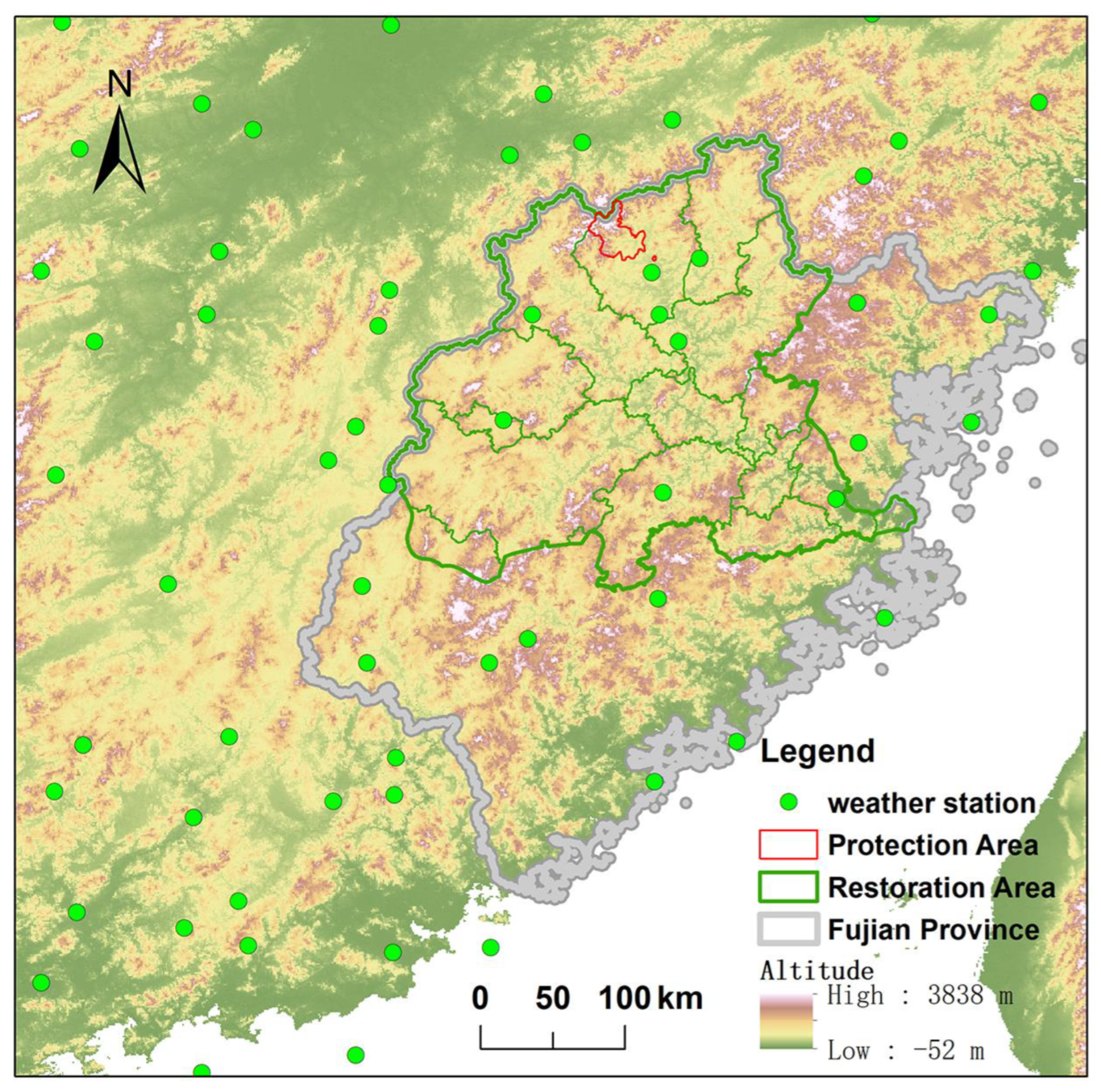
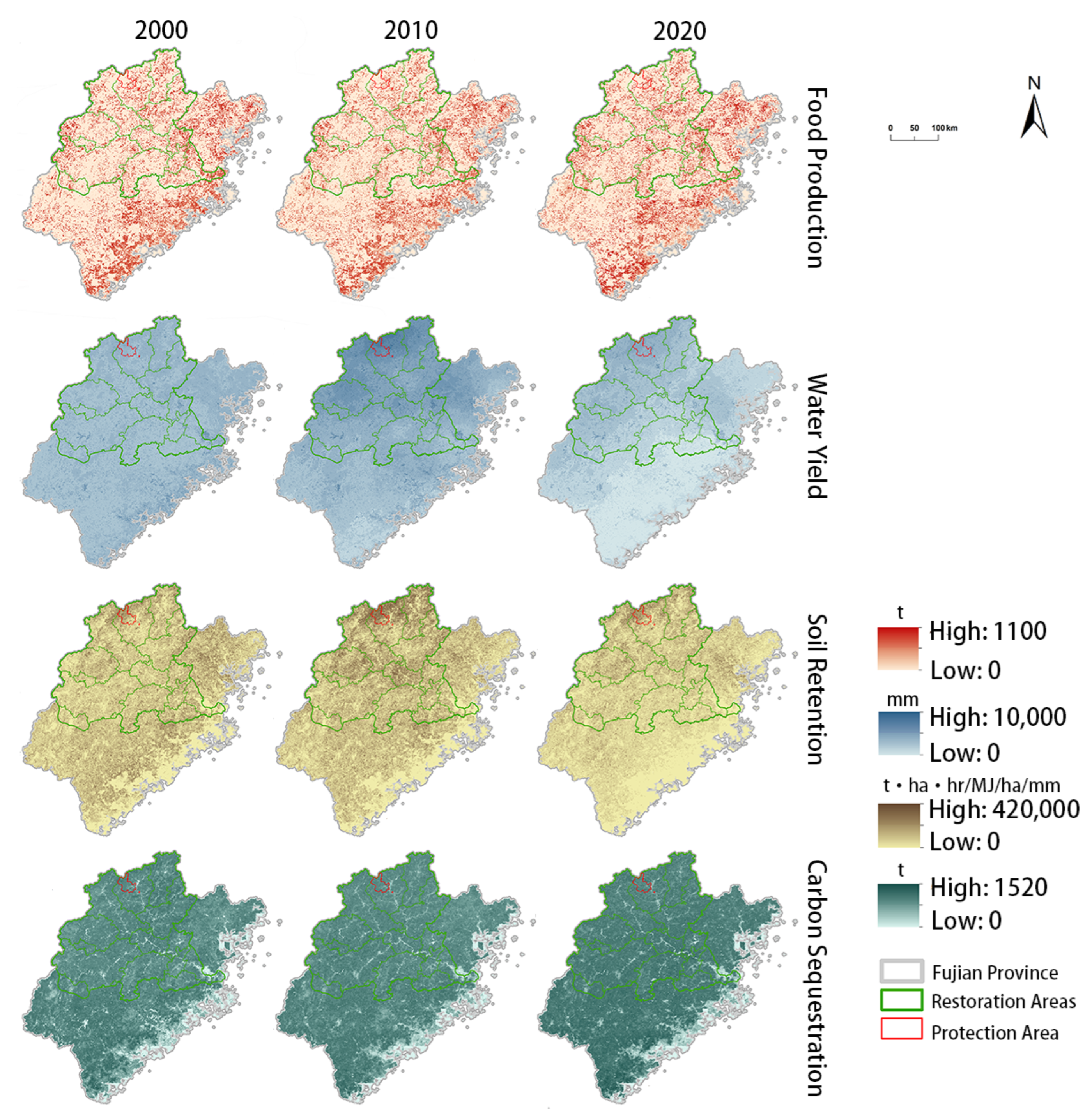
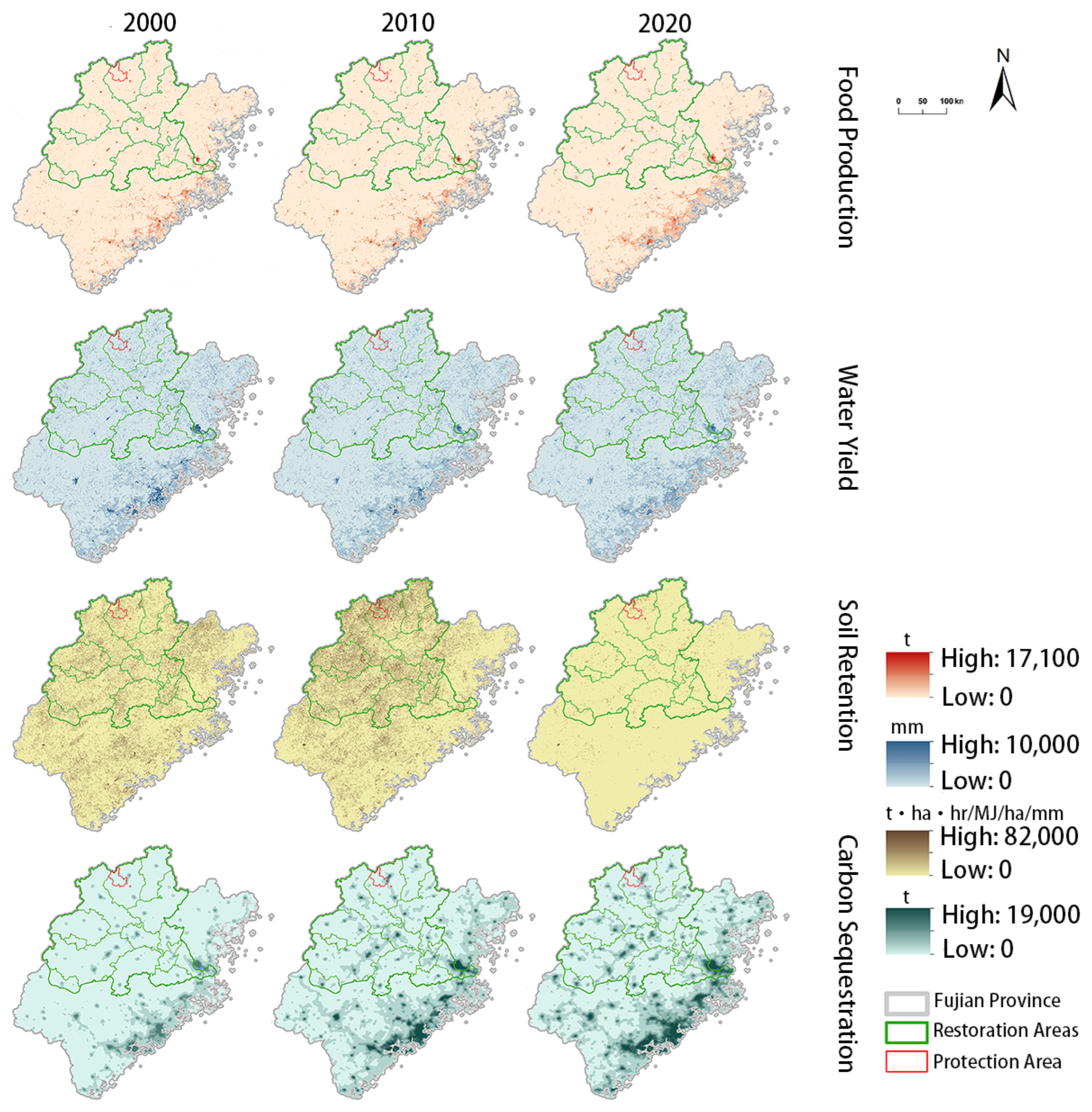
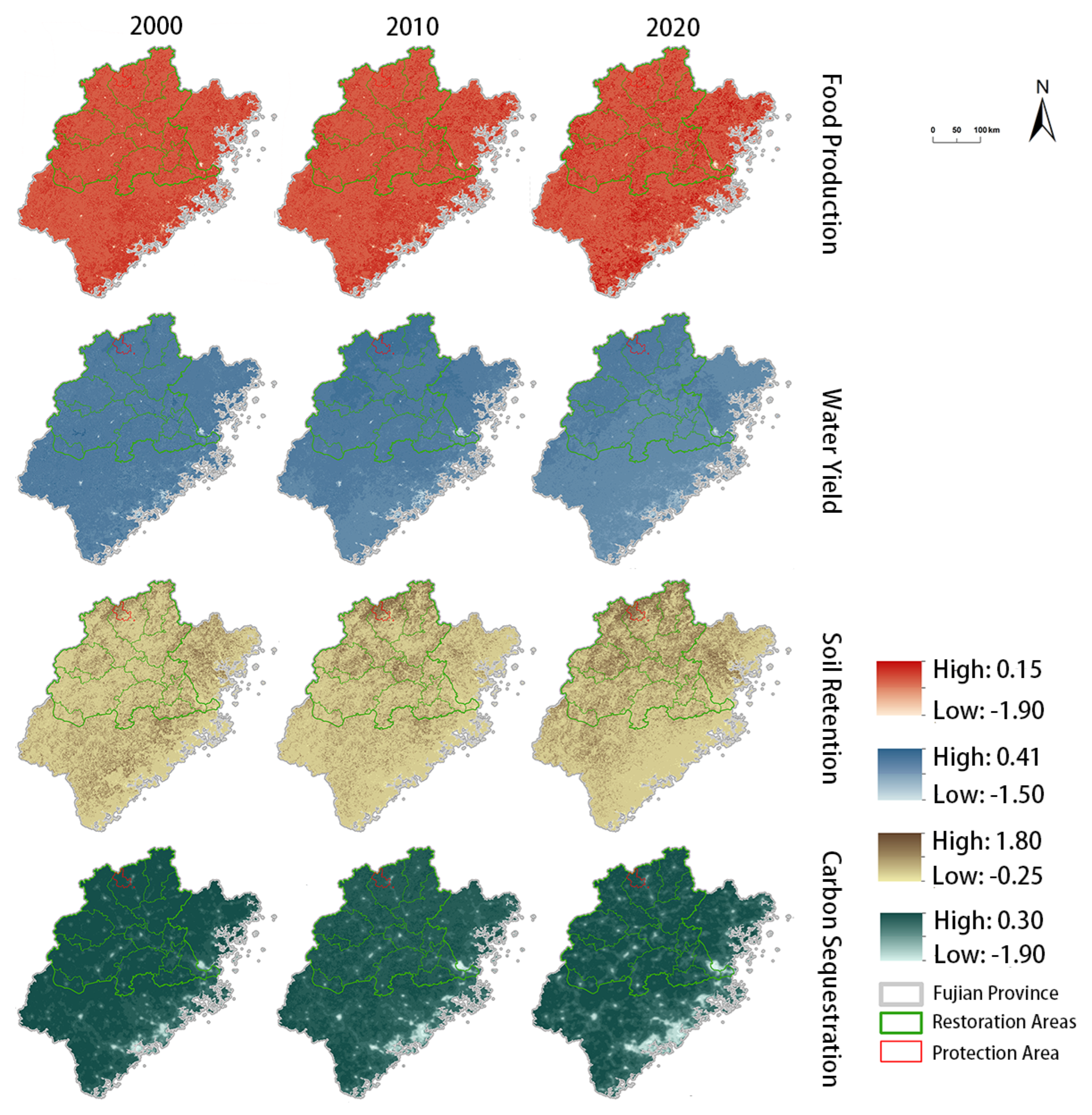
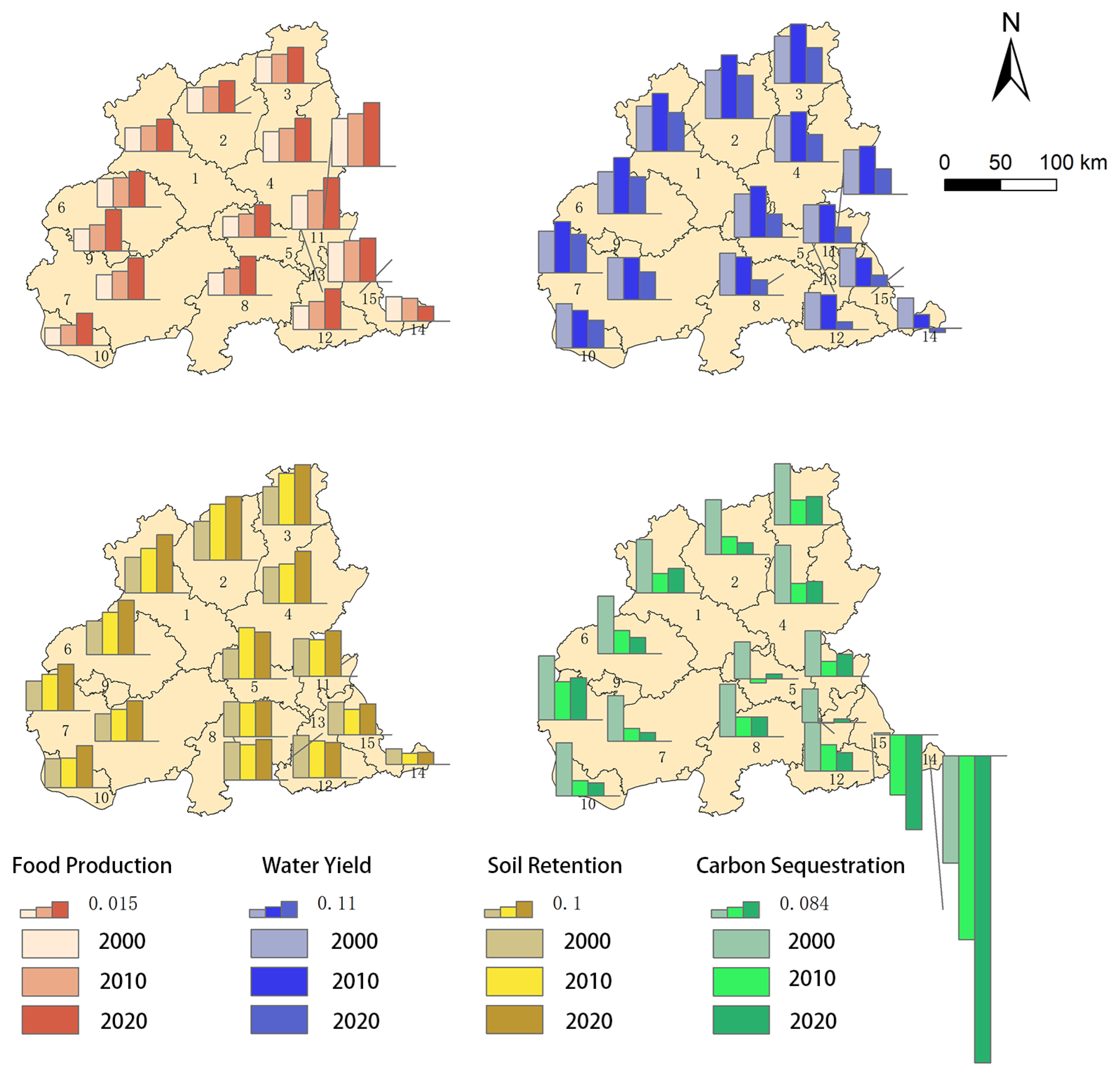
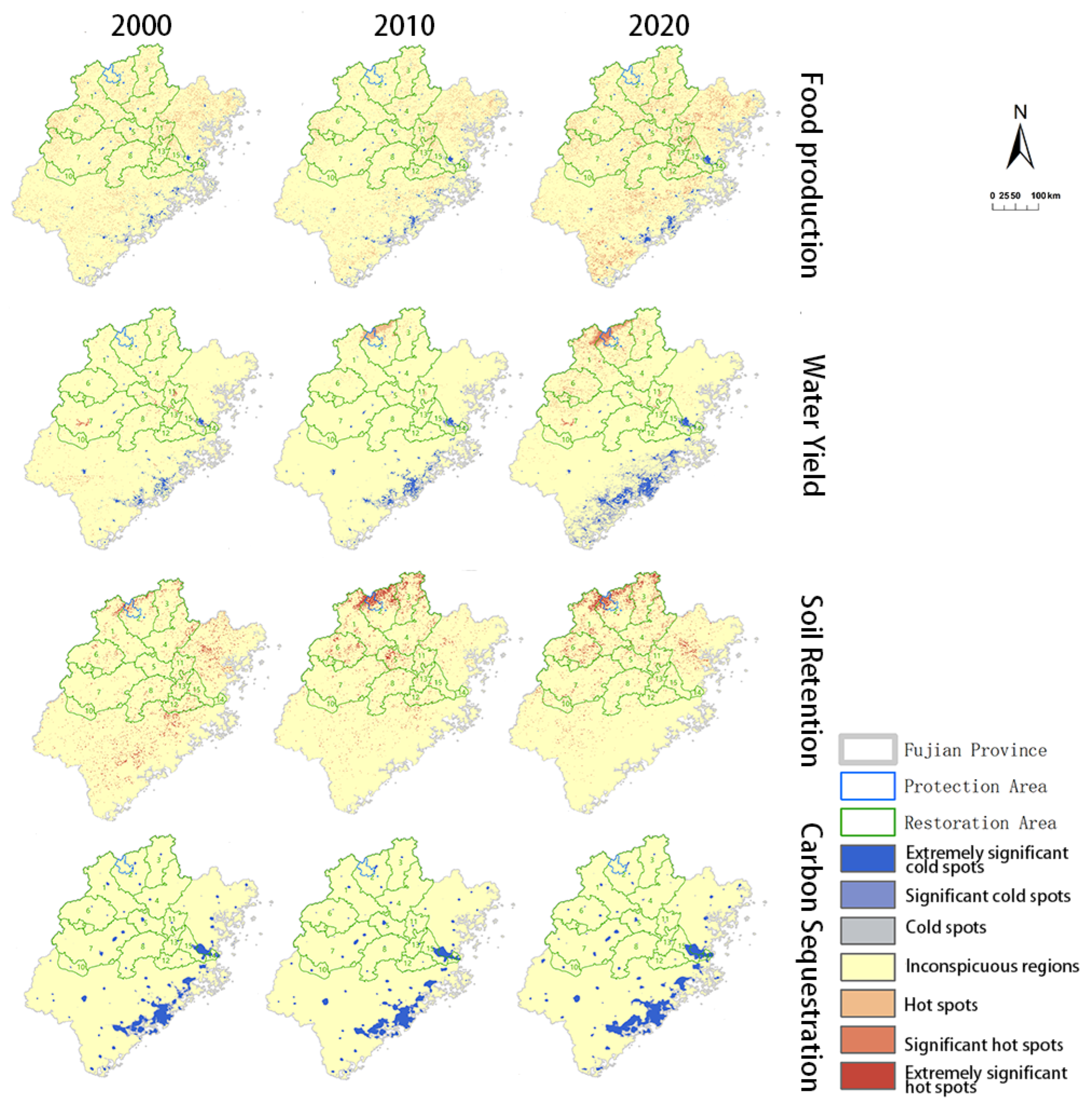
| NO. | Main Sub-Project in Minjiang Shan-Shui Initiative |
|---|---|
| 1 | Ecological Protection and Restoration Project at Futun Watershed and Abandoned Mine Comprehensive Improvement Project at Shunchang County |
| 2 | Water Environment Management and Regional Ecological Protection and Restoration Project at Chongyang sub-watershed and River Comprehensive Improvement and Regional Ecological Protection and Restoration Project at Nanpu watershed |
| 3 | Comprehensive Remediation of Abandoned Mines and Heavy Metal Contaminated Land Restoration Project at Pucheng County |
| 4 | Water Environment Management and Regional Biodiversity Protection Project at Songxi and Jianxi sub-watershed and the surrounding area |
| 6 | Ecological Protection and Restoration Project at Jinxi sub-watershed |
| 5 | Water Environment Management and Regional Ecological Protection and Restoration Project at Yanping Section of Minjiang River and Ecological Monitoring and Management Capacity Building Project at Nanping City |
| 8 | Ecological Protection and Restoration Project at Youxi sub-watershed |
| 9 | International Migratory Bird Migration Corridor Protection and Restoration Project in the Mingxi Section of the Shaxi sub-watershed |
| 7 | Ecological Protection and Restoration Project at Shaxi sub-watershed; Abandoned mine environment restoration and geological disaster prevention and control project; and Ecological Monitoring and Management Capacity Building Project at Sanming city |
| 10 | Water Source Protection and Regional Ecological Protection and Restoration Project at upstream of Shaxi sub-watershed |
| 11 | Water Environment Management and Regional Ecological Protection and Restoration Project at Gutianxi sub-watershed |
| 12 | Water Environment Management and Regional Ecological Protection and Restoration Project Dazhangxi sub-watershed |
| 13 | Water Environment Management and Regional Ecological Protection and Restoration Project Meixi sub-watershed |
| 14 | Water Environment Management and Wetland Protection Project at Changle section of Minjiang river |
| 15 | Water Environment Management and Wetland Protection Project at Houle section of Minjiang river |
| Hot/Cold Spot Level | z-Score | p-Value |
|---|---|---|
| Extremely significant hot spots | >2.58 | <0.01 |
| Significant hot spots | 1.96–2.58 | <0.05 |
| Hot spots | 1.65–1.96 | <0.10 |
| Inconspicuous regions | −1.65–1.65 | - |
| Cold spots | −1.96–1.65 | <0.10 |
| Significant cold spots | −2.58–1.96 | <0.05 |
| Extremely significant cold spots | <2.58 | <0.01 |
| Area | 2000 | 2010 | 2020 | VR2000-2010 (%) | VR2010-2020 | VR2000-2020 |
|---|---|---|---|---|---|---|
| FP supply (t) | ||||||
| Total | 178.18 | 169.81 | 186.52 | −4.70% | 9.84% | 4.47% |
| OM | 206.01 | 195.23 | 206.80 | −5.23% | 5.93% | 0.38% |
| MJ | 146.97 | 141.30 | 163.76 | −3.86% | 15.90% | 10.25% |
| WYS | 94.16 | 83.28 | 100.83 | −11.56% | 21.08% | 6.62% |
| WY supply (mm) | ||||||
| Total | 778.41 | 830.33 | 329.07 | 25.76% | −51.89% | −65.27% |
| OM | 784.67 | 986.79 | 474.79 | 6.67% | −60.37% | −136.55% |
| MJ | 791.70 | 1162.27 | 638.24 | 46.81% | −45.09% | −24.04% |
| WYS | 923.80 | 1663.20 | 1024.47 | 80.04% | −38.40% | 9.83% |
| CS supply (t) | ||||||
| Total | 877.27 | 896.58 | 995.34 | 2.20% | 11.02% | 11.86% |
| OM | 849.97 | 873.31 | 977.90 | 2.75% | 11.98% | 13.08% |
| MJ | 907.89 | 922.68 | 1014.91 | 1.63% | 9.99% | 10.54% |
| WYS | 926.79 | 903.84 | 954.89 | −2.48% | 5.65% | 2.94% |
| SR supply (t·ha·hr/MJ/ha/mm) | ||||||
| Total | 24,332.42 | 27,565.26 | 17,763.13 | 13.29% | −35.56% | −36.98% |
| OM | 23,988.00 | 21,808.99 | 13,599.52 | −9.08% | −37.64% | −76.39% |
| MJ | 24,716.97 | 33,992.29 | 22,411.75 | 37.53% | −34.07% | −10.29% |
| WYS | 39,871.96 | 69,773.56 | 41,362.85 | 74.99% | −40.72% | 3.60% |
| Year | FP & WY | FP & SR | FP & CS | WY & SR | WY & CSW | CS & SR | |
|---|---|---|---|---|---|---|---|
| Total | 2000 | 0.31 ** | −0.16 ** | −0.18 ** | −0.07 ** | −0.24 ** | 0.42 ** |
| 2010 | 0.08 ** | −0.17 ** | −0.13 ** | 0.35 ** | −0.04 ** | 0.36 ** | |
| 2020 | 0.05 ** | −0.15 ** | −0.06 ** | 0.37 ** | −0.05 ** | 0.30 ** | |
| OM | 2000 | 0.27 ** | −0.16 ** | −0.17 ** | −0.13 ** | −0.31 ** | 0.45 ** |
| 2010 | 0.11 ** | −0.15 ** | −0.11 ** | 0.15 ** | −0.13 ** | 0.44 ** | |
| 2020 | 0.01 | −0.13 ** | −0.05 ** | 0.29 ** | −0.07 ** | 0.38 ** | |
| MJ | 2000 | 0.37 ** | −0.17 ** | −0.19 ** | 0.01 * | −0.11 ** | 0.37 ** |
| 2010 | 0.20 ** | −0.17 ** | −0.17 ** | 0.31 ** | −0.06 ** | 0.31 ** | |
| 2020 | 0.22 ** | −0.15 ** | −0.08 ** | 0.21 ** | −0.15 ** | 0.24 ** | |
| WYS | 2000 | 0.21 ** | −0.23 ** | −0.35 ** | 0.33 ** | 0.23 ** | 0.47 ** |
| 2010 | 0.18 ** | −0.20 ** | −0.25 ** | 0.40 ** | 0.08 * | 0.328 ** | |
| 2020 | 0.19 ** | −0.22 ** | −0.12 ** | 0.29 ** | −0.03 | 0.13 ** |
| Location | 2000 | 2010 | 2020 | VR2000-2010 | VR2010-2020 | VR2000-2020 |
|---|---|---|---|---|---|---|
| FP demand (t) | ||||||
| Total | 72.42 | 62.72 | 65.00 | −13.39% | 3.64% | −11.40% |
| OM | 103.27 | 92.49 | 99.05 | −10.44% | 7.09% | −4.26% |
| MJ | 38.08 | 29.50 | 26.88 | −22.53% | −8.87% | −41.64% |
| WYS | 10.49 | 5.98 | 8.04 | −42.94% | 34.40% | −30.41% |
| WY demand (mm) | ||||||
| Total | 140.01 | 160.62 | 140.30 | 14.72% | −12.65% | 0.21% |
| OM | 188.59 | 230.98 | 189.29 | 22.48% | −18.05% | 0.37% |
| MJ | 86.07 | 82.33 | 85.61 | −4.34% | 3.98% | −0.54% |
| WYS | 49.78 | 39.72 | 46.82 | −20.21% | 17.87% | −6.33% |
| CS demand (t) | ||||||
| Total | 479.54 | 1194.56 | 1554.68 | 149.11% | 30.15% | 69.16% |
| OM | 733.94 | 1751.45 | 2271.15 | 138.64% | 29.67% | 67.68% |
| MJ | 194.34 | 570.25 | 751.47 | 193.43% | 31.78% | 74.14% |
| WYS | 103.09 | 482.24 | 388.24 | 367.80% | −19.49% | 73.45% |
| SR demand (t·ha·hr/MJ/ha/mm) | ||||||
| Total | 1112.46 | 1352.01 | 306.91 | 21.53% | −77.30% | −262.47% |
| OM | 1106.26 | 983.83 | 241.24 | −11.07% | −75.48% | −358.58% |
| MJ | 1119.37 | 1763.09 | 380.23 | 57.51% | −78.43% | −194.39% |
| WYS | 1355.77 | 3558.49 | 735.13 | 162.47% | −79.34% | −84.43% |
| FP | SR | CS | WY | |||||||||
|---|---|---|---|---|---|---|---|---|---|---|---|---|
| 2000 | 2010 | 2020 | 2000 | 2010 | 2020 | 2000 | 2010 | 2020 | 2000 | 2010 | 2020 | |
| Total | 0.01 | 0.01 | 0.02 | 0.11 | 0.11 | 0.12 | 0.07 | −0.03 | −0.06 | 0.14 | 0.13 | 0.06 |
| OM | 0.01 | 0.01 | 0.01 | 0.11 | 0.08 | 0.10 | 0.02 | −0.09 | −0.14 | 0.13 | 0.10 | 0.03 |
| MJ | 0.01 | 0.01 | 0.02 | 0.11 | 0.13 | 0.16 | 0.13 | 0.04 | 0.03 | 0.16 | 0.18 | 0.10 |
| WYS | 0.01 | 0.01 | 0.01 | 0.18 | 0.27 | 0.29 | 0.15 | 0.04 | 0.06 | 0.19 | 0.26 | 0.18 |
Disclaimer/Publisher’s Note: The statements, opinions and data contained in all publications are solely those of the individual author(s) and contributor(s) and not of MDPI and/or the editor(s). MDPI and/or the editor(s) disclaim responsibility for any injury to people or property resulting from any ideas, methods, instructions or products referred to in the content. |
© 2023 by the authors. Licensee MDPI, Basel, Switzerland. This article is an open access article distributed under the terms and conditions of the Creative Commons Attribution (CC BY) license (https://creativecommons.org/licenses/by/4.0/).
Share and Cite
Zhang, X.; Wang, J.; Zhao, M.; Gao, Y.; Liu, Y. Variations of Ecosystem Services Supply and Demand on the Southeast Hilly Area of China: Implications for Ecosystem Protection and Restoration Management. Land 2023, 12, 750. https://doi.org/10.3390/land12040750
Zhang X, Wang J, Zhao M, Gao Y, Liu Y. Variations of Ecosystem Services Supply and Demand on the Southeast Hilly Area of China: Implications for Ecosystem Protection and Restoration Management. Land. 2023; 12(4):750. https://doi.org/10.3390/land12040750
Chicago/Turabian StyleZhang, Xiao, Jun Wang, Mingyue Zhao, Yan Gao, and Yanxu Liu. 2023. "Variations of Ecosystem Services Supply and Demand on the Southeast Hilly Area of China: Implications for Ecosystem Protection and Restoration Management" Land 12, no. 4: 750. https://doi.org/10.3390/land12040750
APA StyleZhang, X., Wang, J., Zhao, M., Gao, Y., & Liu, Y. (2023). Variations of Ecosystem Services Supply and Demand on the Southeast Hilly Area of China: Implications for Ecosystem Protection and Restoration Management. Land, 12(4), 750. https://doi.org/10.3390/land12040750






